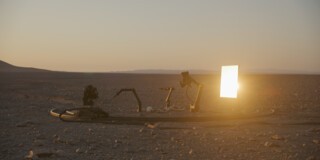Asmall, pale limulus horseshoe crab, one of those prehistoric-looking creatures with long tails, scuttles across the sandy bed of a large aquarium. From behind a boulder improbably suspended in the water appears a long-legged arrow crab, with its distinctive Eiffel Tower-shaped head and spindly scarlet legs. The arrow crab picks up something white with a pincer and begins to munch on it, as the limulus capsizes and waves its legs helplessly in the air. The scene wouldn’t have been much different 500 million years ago, in the period known as the Cambrian explosion, when complex life forms first emerged. The event gives the title to the work Cambrian Explosion 19 (2013) by the French artist Pierre Huyghe, on display in the exhibition Liminal, curated by Anne Stenne, at the Punta della Dogana in Venice (until 24 November).
As I stood looking into the tank, two people dressed in black appeared behind me. Their faces were entirely obscured by polished golden masks that emitted an LED glow. They stood perfectly still, like sci-fi mannequins. In a strange electronic voice one of the masks, or some mechanism inside it, spoke a word which sounded very much like ‘hotel’, then fell silent again. The figures moved off and took up a new position in the corner of the room.
The golden masks are described in the exhibition catalogue as artificial intelligence devices ‘sensitive to external stimuli, some of which are imperceptible’. ‘Each sense,’ Huyghe says, ‘gathers information and converts specific characteristics into a language that the masks worn by humans convey through the space.’ The catalogue claims that over time the masks will form a ‘community’, ‘an entity without body’ that speaks ‘an unprecedented form of language’. How it all works is perhaps irrelevant and is left unexplained in the exhibition, which creates an ethereal atmosphere heightened by the darkness of the space. It feels a little like being underwater, images and objects floating in aphotic ocean depths. There is something Kubrickian about the golden masks, the deliberate estrangement and the obsession with questions real and artificial, human and posthuman. Huyghe is staging an epic collision between the origins of organic life and its most recent (and maybe final) manifestation, in the form of sentient technology. ‘Hotel’, the LED mask intones, as if it were the first and last word ever to be spoken.
Sometimes the human and posthuman are combined. On a big screen in the first room, a naked woman proceeds through a series of motions, her body illuminated by a pallid lunar light: walking in an empty landscape, crouching, crawling, jerking with sudden spasms. She brings her hand to her face, but can’t see it. She has no face: her head is entirely hollow, with a dark aperture where her features should be. Her strange movements give the impression that she is not responding to her environment but is being controlled by unseen forces. I was reminded of Manet’s Olympia, partly by the woman’s physical appearance but also by the sense of a body being held, as the title of the work (and of the exhibition) suggests, in a liminal state. Her naturalism is striking, yet she is, of course, a computer-generated image. Her movements are determined by a ‘brain organoid located in a lab’ in New York, made of ‘a few synthetic neural circuits’. Since the ‘brain organoid’ is invisible to us, and the term itself impenetrable, we can only be absorbed by what we see: the spectacle of a woman’s body incarnated by endtimes technology. At one point she seems to reach the edge of her flat digital earth, standing motionless before a data void of darkness, waiting to be told what to do. She might be the first posthuman in a world where the hominid body survives only as a digital fossil.
Alongside her is the self-effacing sculpture Estelarium, a low block of basalt that appears to have been cast from a heavily pregnant belly. The sculptural void mirrors the absent face in the film playing above: instead of a synthetic digital human in a posthuman world, here is the human as instinctive animal, without will or subjecthood, imprinted in rock, given purpose and form only by the task of species continuation. It is the Willendorf Venus again.
At the centre of the exhibition, Camata (2024) plays on a panoramic screen. On the rocky surface of the Atacama Desert in Chile (the driest place on earth) lies a skeleton, seemingly in the position where the human it bore fell and died many years ago. The film stages a forensic examination of the skeleton by remote-controlled cameras mounted on a semicircle of dolly track; robot arms and pincers comb the detritus. The camera lingers over details of the crumbling skeleton, the focus roving across torn scraps of clothing, decaying shoes and grey-brown desiccated viscera. The sun rises and sets, casting a peachy orange glow. At night the scene is illuminated by the silver light of a full moon. The movements of the camera, drawing in and out of focus, suggest the unhurried, machine-controlled precision of a lunar probe. In some shots, strange objects – polished metal cones, glass spheres – appear next to the skeleton and are lifted and moved, without clear pattern or purpose, by the robot fingers.
With film installations in dark galleries there is always the question of when-did-it-start and how-long-will-this-last. That doesn’t apply to Camata. It is a ‘self-directed’ film being edited, we are told, in ‘real time’, using sensory input from a golden sphere mounted on the wall of the gallery that responds to the movements of visitors. How these data are translated into the film’s cuts and switches of angle is impossible to know, but the images roll on in endless unpredictable sequence.
This unpredictability underscores the notion of the whole exhibition as a performance: a post-apocalyptic carnival around which the golden-masked figures wander, harvesting data. The helmets were designed by Bottega Veneta, appropriately enough for Venice, a city where masks have long been part of public life. Masking is also the subject of Huyghe’s film Human Mask (2014), one of the earliest works on display. We watch the unnerving antics of a macaque monkey wearing the mask and wig of a young girl, running around a deserted restaurant in Fukushima, three years after the earthquake and the meltdown of the nuclear power plant. (The film was shot in Utsunomiya, north of Tokyo. Huyghe was inspired by a local restaurant where customers were served by a macaque called Fuku-chan.) The exterior shots of Fukushima’s dripping ruins and the nightmarish apparition of the masked macaque have a sideshow thrill, Fuku-chan’s movements mimicking the circus trick of serving customers, but then descending into grim mania: she spins around, bangs on a mirror, rocks back and forth as if in distress. We see her long furry paws, plantigrade like a human foot, and her dark eyes through the slits in the Noh mask, but it remains difficult to accept that this creature is either fully human or fully monkey.
You might think all this would be chilling, but in fact it is fascinating to watch the close-up interrogation of the skeletal body in Camata, to admire the way the cameras and robot arms go about their work of silent observation, just as it is to watch the movements of a young girl who is in fact a monkey, or the unreal motion of a faceless woman being controlled by a brain in a New York laboratory. There is something almost comforting about the intimacy of the technology, the way the focus lingers over details of the human form or seems to contemplate the slow, fluid movements of the arrow crab and limulus.
Sometimes the images are sublime. Macroscopic and microscopic cameras in the film De-extinction (2014) scan a block of amber in which ancient insects are preserved, two in an act of prehistoric copulation, creating a ravishing cosmic spectacle. Air bubbles appear like galaxies in deep space, the camera probing deeper as if we are getting close to the moment of creation itself. Art can’t measure up to the scale of climate disaster and mass extinction lurking in the wings of Huyghe’s grand stage. But we can keep marvelling, he seems to be saying, even in the aftermath of disaster. This is what it looks like when, regardless of warnings and catastrophes, things just carry on.
Send Letters To:
The Editor
London Review of Books,
28 Little Russell Street
London, WC1A 2HN
letters@lrb.co.uk
Please include name, address, and a telephone number.


